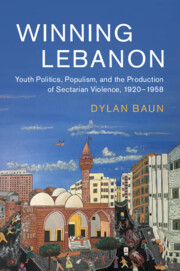Book contents
- Winning Lebanon
- Cambridge Middle East Studies
- Winning Lebanon
- Copyright page
- Dedication
- Epigraph
- Contents
- Figures, Maps, and Tables
- Acknowledgments
- A Note on Conventions
- Introduction
- 1 The Future of Young Men
- 2 Producing Space
- 3 Broadening the Base
- 4 In Defense of Lebanon
- 5 Fighting the Punks
- Epilogue
- Bibliography
- Index
- Books in the Series
3 - Broadening the Base
The Poor, the Countryside, Women, and Abroad
Published online by Cambridge University Press: 16 October 2020
- Winning Lebanon
- Cambridge Middle East Studies
- Winning Lebanon
- Copyright page
- Dedication
- Epigraph
- Contents
- Figures, Maps, and Tables
- Acknowledgments
- A Note on Conventions
- Introduction
- 1 The Future of Young Men
- 2 Producing Space
- 3 Broadening the Base
- 4 In Defense of Lebanon
- 5 Fighting the Punks
- Epilogue
- Bibliography
- Index
- Books in the Series
Summary
Chapter 3 explores the expansion of membership beyond the core demographics of these groups during the 1940s and 1950s. I argue that these groups encouraged the political socialization of new groups and categories of people in new places. By setting up organizational outposts throughout the country, establishing wings for marginalized populations, and connecting the group with relevant populations outside Lebanon, these organizations started to incorporate the countryside, young women, and émigrés into national and regional politics. In turn, this chapter finds that these groups expand the notion of who constituted “youth,” and accordingly, they played a significant, albeit not exclusive, role in solidifying mass, youth politics in Lebanon and the broader Middle East. And although these groups were building a cosmopolitan base in many ways, they were circumscribed by the national, sociopolitical system (whereby sect determined how, or if, people could participate in official politics) in Lebanon, and linked class, gender, and regional inequalities. In turn, contradictions emerged within groups, including membership distinctions between the middle-class, male, urban ideal, and everyone else. Furthermore, competition between these groups played out in terms of overlapping claims of who was – and was not – deemed as backward, or in some cases, “sectarian.”
- Type
- Chapter
- Information
- Winning LebanonYouth Politics, Populism, and the Production of Sectarian Violence, 1920–1958, pp. 97 - 127Publisher: Cambridge University PressPrint publication year: 2020

